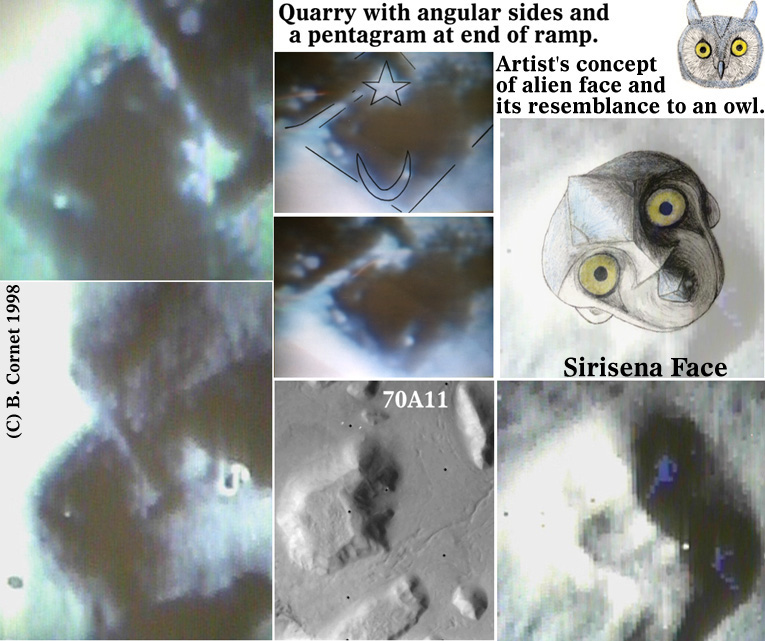- In 1994 Ananda Sirisena, an image processing
expert working for Unisys, gave a lecture in Britain on two artificial
features he discovered about 7.7 miles to the west and 7.7 miles to the
south of the Cydonia anomalies on Mars (Figure 1). They are both visible
in the southwest corner of Viking image 70A11. He sent me and Professor
Stanley McDaniel a copy of a video taken of his lecture, during which he
revealed a quarry or excavation at the eastern end of a mountain located
16 miles southwest of the D&M Pyramid (Figure 2). Within the quarry
one can see relatively straight walls, right angles, tall benches or steps,
and high angled sides to this rectangular-shaped hole, plus a ramp or wall
that appears to extend south from the north side of the quarry into the
middle of the excavated area. There is no indication that this hole was
made by a meteor, and no known geological explanation for how so much of
a mountain could be eroded into a rectangular shape like that with a ramp
or wall squared in orientation to the sides, and a high rock wall forming
closure on the southern side of the excavation. That feature can best be
explained as a remnant of the mountain shaped by the quarry operations,
rather than something that was built up or left standing by erosion.
-

-
-
- But what makes this excavation even more
apparent as an artificial feature is what can be seen inside the quarry.
At the end of the ramp there appears to be a large sculptured pentagram,
and against the western edge of the quarry escarpment there appears to
be a crescent-shaped feature (Figure 2). Together these symbols have profound
religious and metaphysical significance on Earth. The star and crescent
make up a symbol that can be found on a number of national flags, such
as the flags of Pakistan and Turkey.
-
-

-
-
- Finding evidence for a possible excavation
and sculpture is significant enough, but Sirisena goes on to describe the
discovery of a second "face" at the eastern end of an elongate
mountain, located just to the south of the quarry (Figure 1). Unlike the
alleged alien face in the "City" of Cydonia, which does not have
recognizable anthropomorphic features, the Sirisena Face (named here after
its discoverer) is oriented the same way as the anthropomorphic "face",
is about the same size, and has similar pronounced features. But unlike
the well known Face of Cydonia, the Sirisena Face appears to be bilaterally
symmetrical with two well-defined eye sockets, a pronounced nose, and a
beak-like mouth (Figure 2). The cranium is unusually large, and has what
appears to be some sort of diamond-shaped ornamentation or crest that extends
down onto the forehead. On the left side of the Sirisena Face can be detected
what may be an ear protruding out near the base of the cranium. The large
eye sockets, beak-like mouth, and angular ornament on the forehead give
this face a distinctive owl-like resemblance. But until better images can
be obtained of this face and the quarry, we will have to wonder what better
resolution will reveal. As with the new MGS images of the Cydonia Face,
better resolution will certainly modify any interpretation based on the
Viking images.
-
- Yours truly,
- Bruce Cornet, Ph.D.
- Geologist and Paleontologist
-
- bcornet@monmouth.com
- http://www.OrionWorks.com/bcornet/
- http://www.abcfield.force9.co.uk/bcornet/
- http://www.planetarymysteries.com/genisis-geneset.html
- http://www.eagle-net.org/phikent/orbit/april/serpents.html
-
- 27 Tower Hill Ave.
- Red Bank, NJ 07701
- (732) 747-9244
|